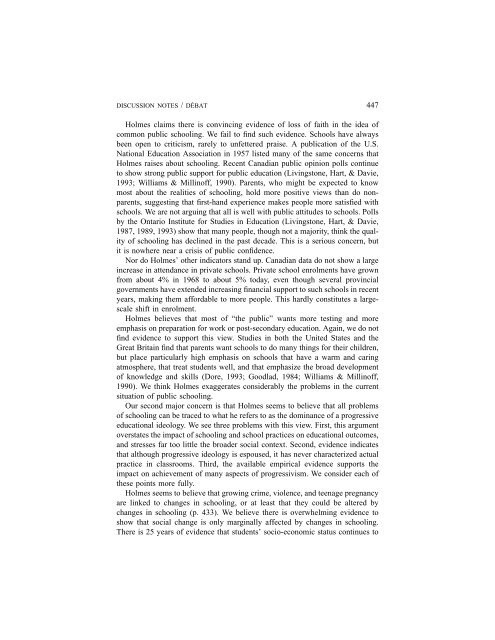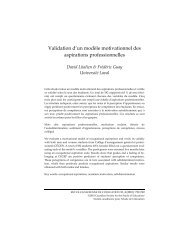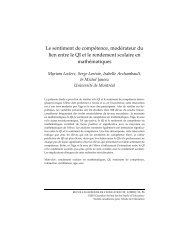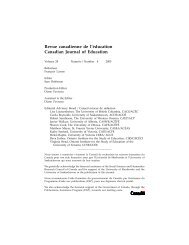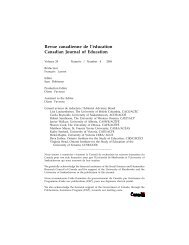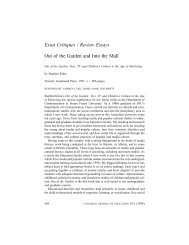Mireille Falardeau et Michel Loranger Le choix de stratégies ... - CSSE
Mireille Falardeau et Michel Loranger Le choix de stratégies ... - CSSE
Mireille Falardeau et Michel Loranger Le choix de stratégies ... - CSSE
Create successful ePaper yourself
Turn your PDF publications into a flip-book with our unique Google optimized e-Paper software.
DISCUSSION NOTES / DÉBAT 447<br />
Holmes claims there is convincing evi<strong>de</strong>nce of loss of faith in the i<strong>de</strong>a of<br />
common public schooling. We fail to find such evi<strong>de</strong>nce. Schools have always<br />
been open to criticism, rarely to unf<strong>et</strong>tered praise. A publication of the U.S.<br />
National Education Association in 1957 listed many of the same concerns that<br />
Holmes raises about schooling. Recent Canadian public opinion polls continue<br />
to show strong public support for public education (Livingstone, Hart, & Davie,<br />
1993; Williams & Millinoff, 1990). Parents, who might be expected to know<br />
most about the realities of schooling, hold more positive views than do nonparents,<br />
suggesting that first-hand experience makes people more satisfied with<br />
schools. We are not arguing that all is well with public attitu<strong>de</strong>s to schools. Polls<br />
by the Ontario Institute for Studies in Education (Livingstone, Hart, & Davie,<br />
1987, 1989, 1993) show that many people, though not a majority, think the quality<br />
of schooling has <strong>de</strong>clined in the past <strong>de</strong>ca<strong>de</strong>. This is a serious concern, but<br />
it is nowhere near a crisis of public confi<strong>de</strong>nce.<br />
Nor do Holmes’ other indicators stand up. Canadian data do not show a large<br />
increase in attendance in private schools. Private school enrolments have grown<br />
from about 4% in 1968 to about 5% today, even though several provincial<br />
governments have exten<strong>de</strong>d increasing financial support to such schools in recent<br />
years, making them affordable to more people. This hardly constitutes a largescale<br />
shift in enrolment.<br />
Holmes believes that most of “the public” wants more testing and more<br />
emphasis on preparation for work or post-secondary education. Again, we do not<br />
find evi<strong>de</strong>nce to support this view. Studies in both the United States and the<br />
Great Britain find that parents want schools to do many things for their children,<br />
but place particularly high emphasis on schools that have a warm and caring<br />
atmosphere, that treat stu<strong>de</strong>nts well, and that emphasize the broad <strong>de</strong>velopment<br />
of knowledge and skills (Dore, 1993; Goodlad, 1984; Williams & Millinoff,<br />
1990). We think Holmes exaggerates consi<strong>de</strong>rably the problems in the current<br />
situation of public schooling.<br />
Our second major concern is that Holmes seems to believe that all problems<br />
of schooling can be traced to what he refers to as the dominance of a progressive<br />
educational i<strong>de</strong>ology. We see three problems with this view. First, this argument<br />
overstates the impact of schooling and school practices on educational outcomes,<br />
and stresses far too little the broa<strong>de</strong>r social context. Second, evi<strong>de</strong>nce indicates<br />
that although progressive i<strong>de</strong>ology is espoused, it has never characterized actual<br />
practice in classrooms. Third, the available empirical evi<strong>de</strong>nce supports the<br />
impact on achievement of many aspects of progressivism. We consi<strong>de</strong>r each of<br />
these points more fully.<br />
Holmes seems to believe that growing crime, violence, and teenage pregnancy<br />
are linked to changes in schooling, or at least that they could be altered by<br />
changes in schooling (p. 433). We believe there is overwhelming evi<strong>de</strong>nce to<br />
show that social change is only marginally affected by changes in schooling.<br />
There is 25 years of evi<strong>de</strong>nce that stu<strong>de</strong>nts’ socio-economic status continues to


